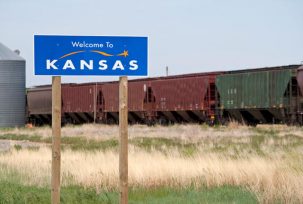How Flat is Kansas?
If you ask your typical American which state is the flattest, there’s a good chance they’ll respond with Kansas. In fact, 1/3 of participants in an American Geographical Society claimed just that. Kansas, the Sunflower State, has the happy distinction of being “flatter than a pancake”: but just how flat is it?

In 2003, a group of geographers decided to take matters into their own hands and actually compare Kansas to a pancake. Using a pancake procured from IHOP, the geographers created a topographic map of the pancake using a laser microscope. After leaving the dials a bit sticky from maple syrup, they compared their topographic pancake to a topographic profile of Kansas. The results?
Using 1.000 as the flatness value of a perfectly flat plain, the geographers found that the pancake scored .957 on the flatness scale. That’s pretty flat, but Kansas beat the pancake with a score of .9997, which the geographers (very scientifically) declared as being “damn flat”.
This study on its own would prove Kansas to be very much flatter than a pancake, but some scientists questioned the methodology. Particularly scientists from Kansas. Lee Allison, of the Kansas Geological Survey, brought some strong arguments against the geographer’s means of measuring the pancake, and other scientists concurred, claiming that the way the experiment was carried out was faulty and would make every state in the U.S. “flatter than a pancake”.
In fact, not only is Kansas probably not flatter than a pancake, it actually doesn’t even make the top five for the US’s flattest states. Using an algorithm that measured human perception of flatness, researchers used elevation data from NASA. They divided the US into a grid and gave each section of the grid a flatness rating, then compared the continental US states for flatness ratings. The top ten? Florida took the crown as the flattest state in the US, followed by Illinois, North Dakota, Louisiana, Minnesota, Delaware, Kansas, Texas, Nevada, and Indiana.
So, it turns out that Kansas has the happy distinction of not being flatter than a pancake, after all, while Florida gets the gold medal in flatness. Why, then, would most people consider Kansas much flatter than Florida? It could be Florida’s large wooded areas, or the presence of water that changes the way people perceive Florida’s flatness compared to Kansas’ large, open spaces.
Does our perception of a place’s flatness really matter, though? Some researchers say that it matters quite a bit, and that when people believe a place to be very flat they can develop a negative attitude about that place; on the other hand, flatness can have some benefits, including planned infrastructure like wind turbines, which require flat land to work at maximum efficiency.
